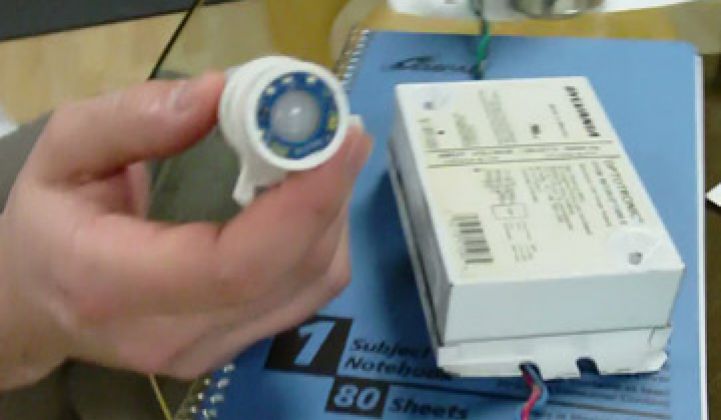In the future, your movements might be followed by Redwood Systems.
The startup -- which came out of stealth last year with a network for LED lights -- is in the midst of expanding the applications for its technology. One retailer is looking at Redwood's ceiling networking as a way to monitor traffic in stores and at check-out counters, said CMO Sam Klepper. If too many customers are waiting in line, Redwood's sensor network could ping someone in facilities or management to open another counter.
Office building owners are also looking at ways of exploiting the technology to make better use of their conference rooms. The network, equipped with motion sensors, will be able to determine whether a conference room is currently being used, as well as whether the whole room is being used or just a portion of it. Historical data can then be mined to optimize this real estate. Another potential application: ambient dust level monitoring for datacenters and office space.
Meanwhile, celebrity customers and partners continue to pile up. Johnson Controls, the building management behemoth, has installed Redwood’s technology at its headquarters and the two companies will work together to integrate Redwood's data into Johnson's systems The law firm of Fenwick & West has put Redwood in its datacenter. Other customers include SAP and real estate developer Equity Office.
Lighting networks could become the next big thing in building management. Although many modern buildings come equipped with management systems, most of these systems only control the HVAC system: Approximately one percent of California office buildings have lighting controls. Lighting, however, consumes 24 percent of energy in commercial office buildings. (Tune in for more on automation and efficiency at our Networked Grid Conference taking place May 3 and 4 in San Francisco.)
Why have lighting controls taken so long to catch on? An hour of aggravation and lost productivity caused by a malfunctioning light controller can be more costly than the electricity it saves. People wearing dark clothes can also fool conventional sensors into thinking that it's suddenly midnight at 11:35 a.m. Redwood has software that compensates for many of these environmental issues, but the fact that each light is surrounded by sensors helps as well. Instead of having to rely on a single sensor in a room to gauge light levels, Redwood's central controller will pull in data from several sensors, allowing it to fine-tune light levels in different zones in the room in an unobtrusive manner.
Companies such as Siemens, EnerNoc, Serious Materials, Honeywell and Schneider Electric have recently bought building management startups, but a predicted run on lighting companies has yet to start. Companies that are likely targets include Redwood, Daintree Networks, Lumenergi, Adura Technologies, Digital Lumens and Lumetric.
Expansion into new applications is possible for Redwood because of the nature of the technology. Redwood's core product is a centralized computer with 64 controllable channels. If a building owner puts LEDs on those channels, the centralized console becomes a tool for managing lighting in buildings. If you add motion and/or temperature sensors, it becomes a combination light network/facilities monitoring service. (Redwood talked about adding different sensors to its network last year, but now it's actually happening.)
"We're pushing the envelope on building intelligence," Klepper, a former eMeter exec, said. "Companies are spending real dollars on conference room monitoring."
Some utilities have also begun to ask if the system could be linked to demand response services.
As an added bonus, the system is fairly cheap, Klepper noted. Instead of wires, Redwood links the sensors to the console with a Cat 5-like networking cable. Consequently, you don't need electrical contractors to install it. Klepper, in fact, even argued that it is cheaper to install Redwood in new construction or as part of a retrofit than conventional lights because of the wiring issues. (That is a sensor cylinder with LED that Redwood might place in your ceiling.) A year ago, the lack-of-wiring issue was somewhat controversial. Redwood was worried that lighting contractors would veer away from the company because it would impinge on their livelihood. But some now believe, says Klepper, that they can lower prices and increase or at least maintain their margins by stringing cable.
A system will pay for itself in two to five years in lower energy bills and maintenance, he said. LEDs consume less power than conventional lights. Swapping out wires for networking cable also allows Redwood to run a building's lights and sensors onto the increasingly popular DC power. (A single console can control around 2,500 square feet of office space, he added.)
Redwood is also looking at ways to link fluorescent lights to its network. Right now, Redwood can only connect to LEDs. Fluorescents, however, still account for 85 percent of the lights in commercial office buildings. Some of Redwood's customers have requested a hybrid solution because they are retrofitting in stages.
Here is a video taken last year with Redwood exec Jeremy Stieglitz explaining how it works.



